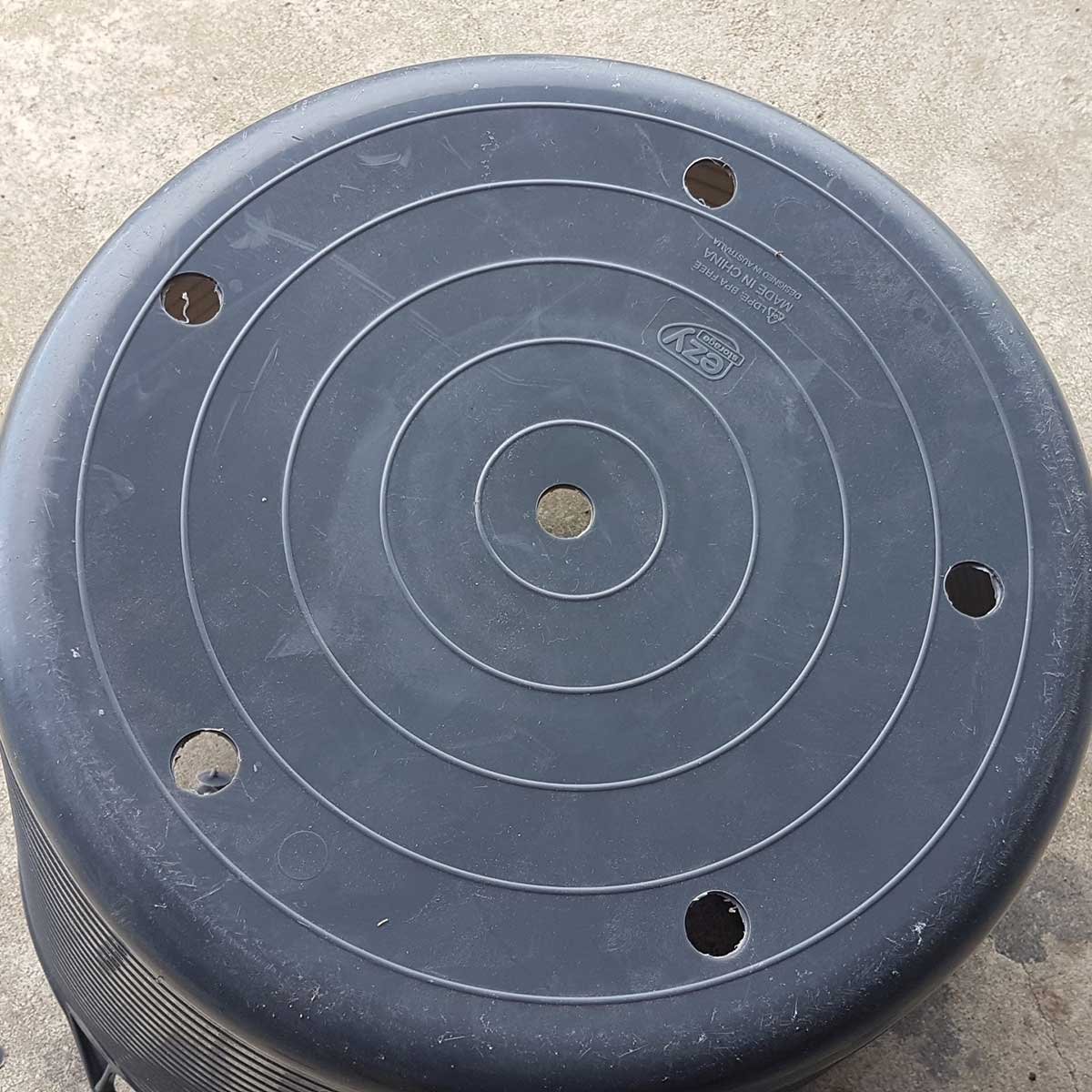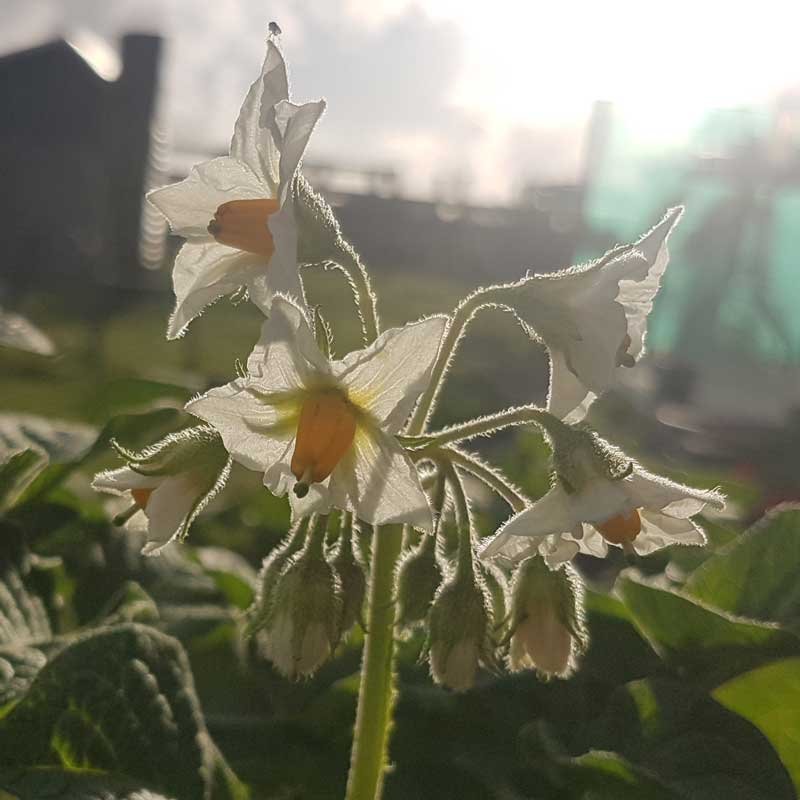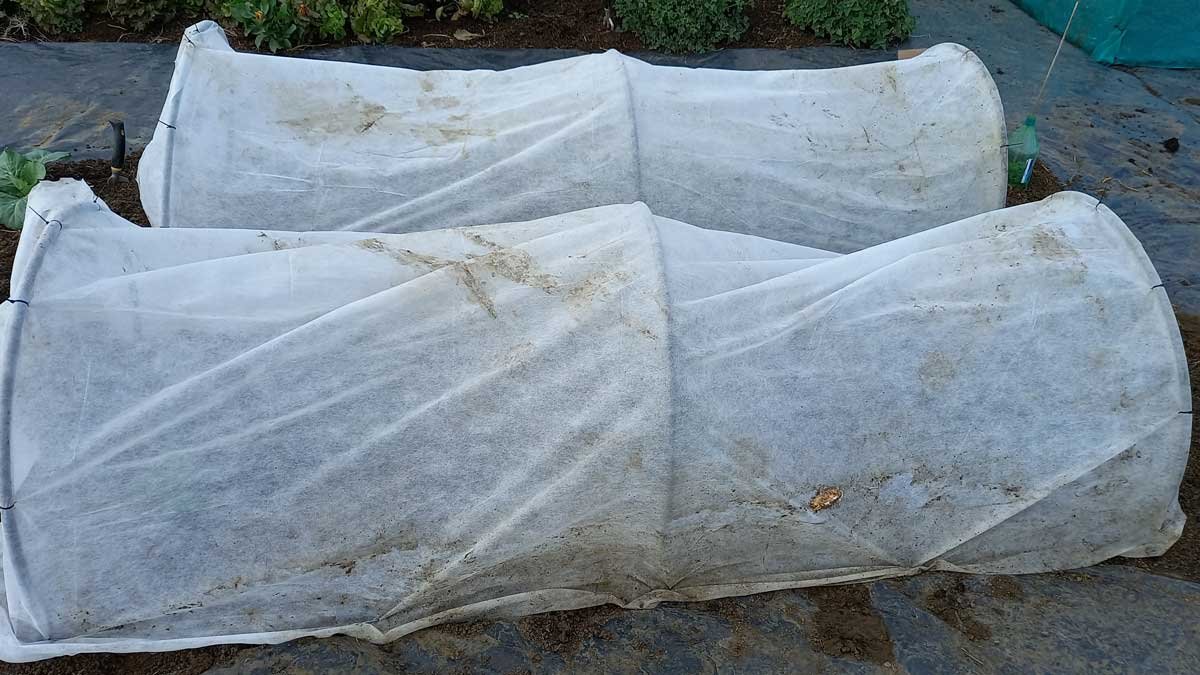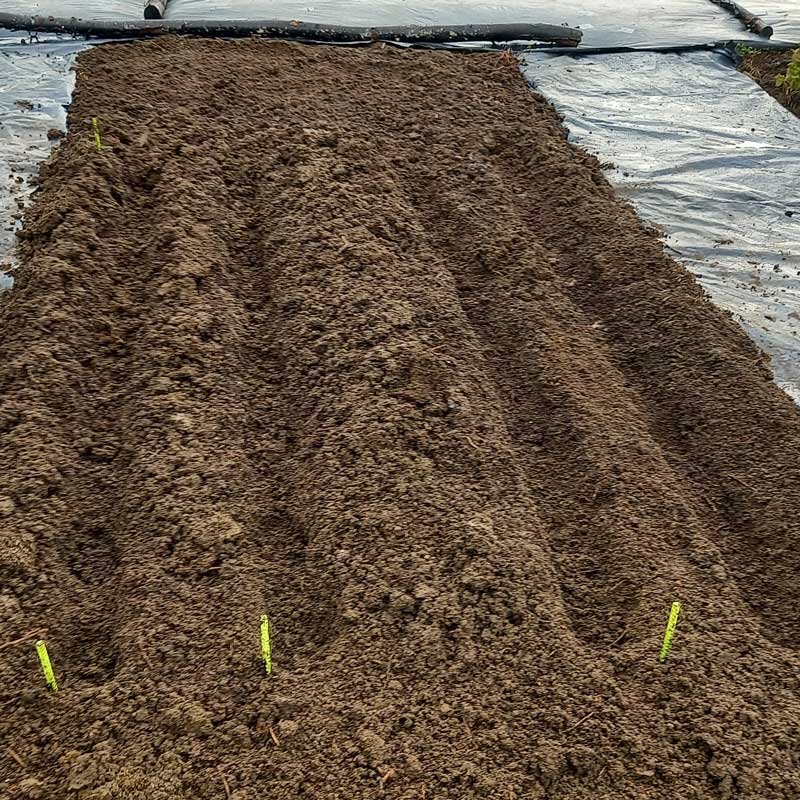This post first published 10 June 2019, and updated 19 September 2021.
Anyone who knows me knows I love growing potatoes. They are like magical tasty gifts from nature when you pull them up out of the ground. Harvesting spuds is one of our favourite jobs on the farm. Which is good – we’re growing a lot of them this year.
You can grow potatoes in pots, or in the garden. You can buy special seed potatoes, or you can plant whatever is sprouting in your cupboard.
Sometimes things go wrong, but often, even when they do, you still have potatoes. In my opinion, they’re the greatest vegetable to grow.
Choosing a potato variety
This is maybe the most confusing part of the process. When you go to the garden center to buy your potatoes, you might see a chart that tells you about them, or you might read the pack and think ‘there’s a lot of jargon here’.
Potatoes can be classified as ‘early’, ‘second early’, or ‘main’. Additionally, they’re either ‘floury’ or ‘waxy’. So let’s break the terms down.
Early and second early potatoes
These are the first spuds you can get in the ground after frosts have passed.
They often mature fastest (Rocket and Swift varieties can mature in 8 weeks!), and these are the spuds you’re most likely to eat as ‘new potatoes’.
Generally, early potatoes won’t store well, while second-early will store for a short period. Early potatoes tend to be harvested and cooked on the same day.
Popular early varieties include Jersey Bennes, Liseta, Cliff Kidney, Rocket, Swift, and Maris Anchor.
Second-early varieties include Nadine, Purple Heart, Red Fantasy, Haylo, and Ilam Hardy.
Main harvest potatoes
These are the ones you grow to store over winter. They’ll take a bit longer, and it’s usually better to plant them a bit later.
I usually aim for mid-late October; with a second round going in around January. But if you live in a region with shorter warm periods, you can plant them at the same time as your earlies.
Popular main varieties include Agria, Rua, Desiree, Red Rascal, and Van Rosa.
Waxy vs floury
When I’m helping people purchase seed potatoes, my first question is always “how do you like to eat potatoes?”
There’s no point growing a spud you don’t want to eat, and we all have our preferences on how to cook them. This is the factor that influences whether you want a floury potato, or a waxy potato.
Floury potatoes fall apart on cooking. That makes them great for mashing, roasting, chips, and baking.
Popular floury potatoes include Ilam Hardy, Karaka, Agria, and Red Rascal.
Waxy potatoes hold their shape when cooked. They’re best for potato salad, casseroles, boiling, or anything else where you don’t want them crumbling to pieces.
Popular waxy varieties include Cliff Kidney, Jersey Bennes, Swift, Nadine, and Rua.
Some potatoes fall in between and are labelled as an “all purpose” potato. These include Liseta, Haylo, Red Fantasy, Moonlight, and Van Rosa.
Taewa
Taewa are potatoes grown by early Māori and passed down to today. They are closer to the original potatoes that came out of South America than the ‘table potatoes’ discussed above.
Breeding programs aimed at keeping these varieties alive mean that they can be found easily on garden center shelves in a range of varieties. They include Kowiniwini, Urenika, Huakaroro, and Moe Moe.
For some great advice on growing taewa and other Māori crops, check out Tahuri Whenua.

Why buy seed potatoes?
Certified seed potatoes are more expensive than the potatoes in your pantry, but they are also guaranteed to be free of disease. That’s what the ‘certified’ means.
The potatoes sprouting in your pantry will grow if you plant them, but they may be harbouring disease. If you bring a virus into your garden, it’s likely you’re never getting rid of it. This is one of the (horticultural) lessons that came from the Irish Potato Famine.
Ultimately, it’s up to you whether you run this risk, but personally I purchase seed potatoes each year. We always harvest back at least twice that value. On a good year it can be more than 5 times the value. In fact, even buying certified seed potatoes, this is one of the best crops for ROI in our garden.
You can pick up seed potatoes from May to October (ish) in your local garden center. Big box stores will sell 1-2kg bags, while specialist garden centers may sell them individually.
It can pay to get in early if you want a more popular variety like Jersey Bennes or Agria.
How many do I need?
It depends on how many you eat, really. We are a potato-heavy household and we grow about 90-95% of what we consume in a year.
To do this, we start the season with about 3kg of an early crop. I play around with varieties, but this year it’s Jersey Bennes – my fave.
Because I live in Northland, I usually get these in around June/July (and protect from rogue frosts). This crop usually begins producing new potatoes when our stored spuds run out (around September), and continues to supply us until our main harvest is ready.
Next up, we plant another 3kg of Agria and Desiree in mid-late October, then repeat it in January. This often returns us over 40kg of potatoes. We cure and store them to get us through winter.
Chitting potatoes
Chitting means to let the potatoes start to go green and grow shoots. This gives them a head-start when you plant them and reduces the chance they’ll just rot in the soil.

The 2021 Agrias set out for chitting.
Keep your seed potatoes somewhere they are dry, but exposed to indirect sunlight. Chitting will take about a month.
I place my potatoes in egg cartons. This keeps air circulating and mostly prevents shoots being accidentally knocked off.
I’ve found rotating the potatoes about once a week helps to develop more shoots as they seem to prefer to shoot on whatever side is pointing up.
Your seed potatoes are ready to plant when your sprouts are 1-2cm long.

Doubling your investment
One technique I’ve begun playing with more recently is cutting my seed potatoes before I plant them. This can double the number of ‘seed potatoes’ you have to plant.
It’s is a tip I picked up from the Joe Gardener Podcast (episode 199). Any potato bigger than an egg should be cut into two or more pieces, around the size of half an egg. Each piece should have at least one sprout.
The pieces are then given a couple of days for the cuts to dry and heal before planting.
Preparing the patch
Avoid adding lime to your garden before potatoes. They prefer a more acidic soil and lime makes the soil more alkaline.
Additionally, fresh compost can also have a negative effect on the quality of your harvest. Both lime and fresh compost are known to increase the prevalence of scab. Scab is rough brown patches on the skin. You can still eat potatoes if they have scab, but it pays to peel them if you have a lot of it.
Potato fertiliser is made with this balance in mind, and if you think your soil needs a boost, is the best additive.
If you are planting in garden beds, then Potato Food is what you want. A 1.5kg bag will prepare up to 5m² of soil.


Preparing the pots
If you are growing in containers, don’t use potato food, it will overload your soil. To be honest, a good quality potting or vegetable mix is really all you need in the 3 or 4 months you’re growing your crop. Generally you need about one bag per container.
But if you want to supercharge you efforts, you can use a slow release fertiliser like Tui Enrich Vege, Tomato, and Herb. You’ll be able to use this in your other containers as well.
One of my favourite containers for potatoes are 40 litre flexi bins with some holes drilled into the bottom. They can take 4 or 5 seed potatoes.
You can also get potato growing bags, complete with a wee flap to make harvesting easy which will do 3 or 4 each, with two in a pack.
This year, I was given two Apache potatoes, and I’ve planted them in a 10 litre bucket with holes in the bottom.

Apache potatoes planted in a bucket. The potatoes were just covered, then watered in.
Timing
In many parts of the country, it’s getting warm enough to plant your early potatoes. The key thing to know is your last frost date.
Potatoes won’t survive a frost, so if a rogue one may still appear, it would pay to find some kind of covering for them. Frost cloth or clear plastic will do the trick.
I plant my early potatoes in the middle of winter because I can in the Far North. But last year I learned the hard way what a very light frost can do, so this year I used frost cloth.
You can plant between your last frost date and January. If that doesn’t leave you much time to stagger them, you can plant both early and main varieties at the same time – your early varieties will mature first while you wait for the mains to die back for longer-term storage.
Protected beds in 2018 – using PVC plastic on cloche hoops.
Planting potatoes
Basically, if you cover your potatoes in soil, they will grow. There are a couple of tricks to making your harvest larger though. It pays to know how a potato grows.
Firstly, those sprouts you just chitted are stems, rather than roots. They should be placed facing up.
The plant will not send potatoes down below the level of the seed potato. Wherever this seed is planted will be the lowest part of the plant. All potatoes it produces will grow at, or above this point.
This is why my grandpa grew his potatoes in trenches about 10-15cm deep – a technique that is working well here for this year’s Jersey Bennes. It allows us to start below the surface, and grow up.
Space your potatoes 20-30cm apart. This gives plenty of room for your spuds to spread out. I do this above the soil level first, and then bury each potato where it’s sitting.
To begin with, you only want your potato 2-3cm below the soil. Barely covered. Then, as they grow, you begin the process of ‘mounding’.
2021 Jersey Bennes placed out in the trenches. Look closely and you can see some of them have been cut in half.
Mounding
When you see leaves appearing at the surface of the soil, bury them.
If you’re growing in trenches, you’ll have some soil available for you to do this, but I also use aged grass mulch, alternating the layers to help improve my soils as I go.
To begin with, the leaves will be small, but you’ll find each time you cover them, they’ll come back twice as fast and twice as large.
Keep going until your container is full, your plants start flowering, or you find it really difficult to add any more – whatever happens first.
Mounding like this encourages potatoes to grow up the stem of the plant under the soil, increasing your harvest. It protects the plants from wind and frost damage as well.
Some mounding has been done to get them to this size, but it’s time to add some serious soil around these babies.
Mulching
Not all potato varieties flower, but when they do it means they are producing tubers below the ground.
This is a really good time to add a thick layer of mulch. I usually use grass clippings that I’ve allowed to rot down for a week or so because it is very freely available to me. But pea straw is also a good option.
This helps stop any tubers toward the top of the soil from turning green and becoming inedible.
We lost about half of last year’s main harvest because I was too lazy to do this step. It was such a stupid mistake, I won’t be making it again.

When can you harvest your potatoes?
You can use the Morton Smith-Dawe chart to check whether the variety you are growing flowers, and how long they take to mature.
Flowers are an easy sign that you can probably have a fossick amongst the soil for some fresh baby potatoes. If your variety doesn’t flower, then you can try about a month before their ‘maturity date’.
For your early potatoes, you can go hard from this point. Once the plants die back, the spuds should be OK in the ground for a month or two – just make sure they are well mulched and grab them for dinner when you want them.

If you’re planning to store your potatoes, you’ll need to let the plants die right back before you lift them. As part of this process, the skins of the potatoes will harden, making them ready for storage.
You can read more about how to harvest and store potatoes in this post.









Hi Kat,
Hope you are both well.
Have you any source for Moringa plants or seeds. Arnie would like to grow them. Its a green leafy veg common in the Philippines.
Cheers Rob
Looks like there’s a few sellers on TradeMe – search under Marketplace > Home & living > Outdoor, garden & conservatory > Plants & trees to filter out all the extracts.
Hello Kat.
Thanks for your newsletters and the excellent potatoes-for-beginners. Wonderfully clear and comprehensive. Almost no beginner knows that they only grow up from the tuber. And often don’t believe me when I tell them.
Containers: If you put holes in the bottom, you need to sit them on bricks so the water can escape. I drill holes around the entire periphery of the outside of the container, as close as I can to the bottom. That way, even if they are sitting on the ground, the water will drain.